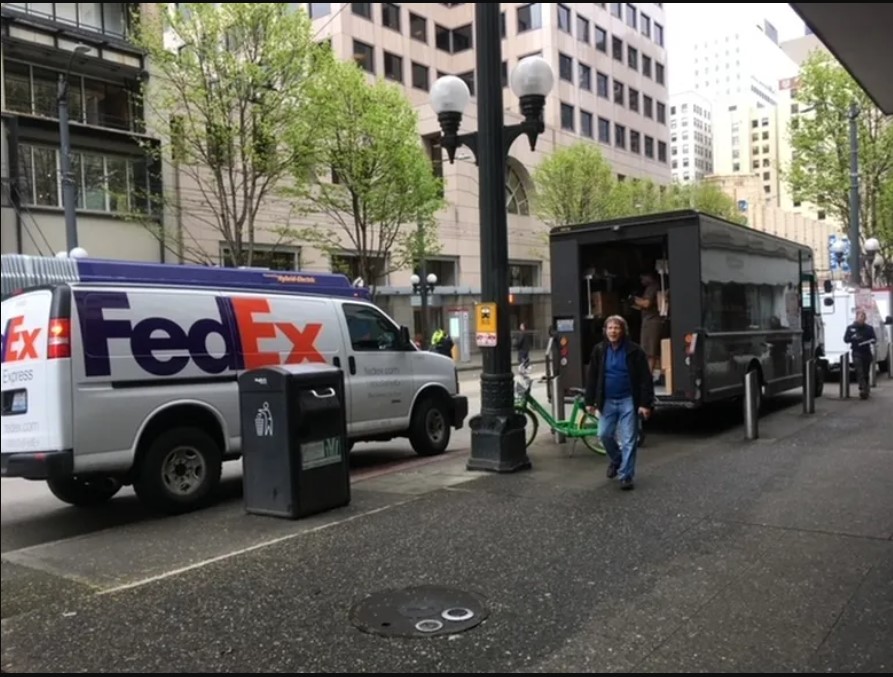
By Megan Kruse and William Justen
In the age of e-commerce, the supply chain now stops at millions of front doors. And with that convenience comes a logistics nightmare.
Cities worldwide are being overrun by urban freight and find their streets and buildings are not designed to manage expanding fleets of trucks and vans bringing a daily flood of parcels.
Freight is essential to Seattle’s economy, jobs and supplying homes and businesses. It must grow safely and sustainably because left unchecked, it’s threatening the city’s priorities for sustainable density, Vision Zero and Carbon Neutral streets.
A new survey of Seattleites says urban freight is among their top transportation priorities. To ensure mobility and minimize impacts, we need updated land use and transportation policies with standards designed to keep our streets moving and people safe. Right now, we’re falling short.
Five years ago, the University of Washington Urban Freight Lab predicted a doubling of goods deliveries and truck trips in the city center by 2023 — even with zero population growth. But Seattle has grown and the pandemic accelerated our reliance on e-deliveries.
Today, a GPS study of 2,900 downtown delivery vehicles reveals 28% of their trip time is spent circling streets for parking — up to 18 extra minutes on some blocks.
As trucks and vans cruise streets for parking — or double-park in streets and alleys causing other vehicles to circle — it quickly accumulates Vehicle Miles Traveled, or VMT.
VMT is a proxy for gauging greenhouse gas emissions and an area’s level of transportation safety, says Fehr & Peers, a national consultancy that advises cities including Seattle. It finds areas with low VMT-generation rates have less frequent and severe collisions.
And with urban freight VMT rising, so have collisions. Federal statistics show fatality rates for collisions on city streets and arterials growing at five times the rate of all vehicle crashes. The rate for nonfatal urban freight crashes has risen 40%.
Environmental costs also are steep. The national Urban Mobility Report on 101 U.S. cities ranks Seattle 11th in excess CO2 from trucks and 15th in annual truck delays and congestion costs.
In our densest city center neighborhoods, excessive freight VMT is a problem of supply and demand. There’s not enough on- and off-street infrastructure to support the rising number of delivery vehicles. More curb parking lanes are being converted for bus and bike use while only 13% of buildings in the city center have off-street loading berths.
To contain urban freight, our buildings and streets must work together.
Three years ago, the Department of Construction and Inspections worked with other city departments and community stakeholders to produce a Director’s Rule establishing new residential loading berth requirements for city center neighborhoods where freight impacts are intense.
That legislation stalled and since then new residential towers for up to 1,000 people have been approved without any loading berths. At the urging of downtown residents and business owners, District 7 Councilmember Andrew Lewis has asked SDCI to resubmit its loading legislation by June 30. So far, there’s no sign this will happen.
We can’t continue to design new buildings the way they did 100 years ago without areas for trucks and waste staging. Innovative transportation policies promise to help, but with finite curb space there’s not enough capacity without new freight-compatible buildings.
If we can’t get it right downtown, the same impacts could be repeated in large developments across Seattle in new urban centers and villages under the One Seattle Plan.
With public backing and urban freight studies for guidance, we need committed leadership and action. Until then, each new building lacking infrastructure to contain its transportation impacts will become a long-term burden on public safety and the environment.